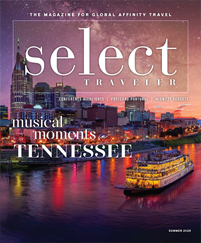The way to travelers’ hearts is through their stomachs, and Travel Alliance Partners dish up plenty of culinary experiences on their itineraries. TAP travelers can tour the Tillamook Cheese Factory in Oregon, cook up some jambalaya in “N’awlins” and go crabbing in Chesapeake Bay, among other great food-focused activities.
Culinary Institutes of America
Hyde Park, New York
Visiting the Culinary Institutes of America’s (CIA’s) Hyde Park campus in New York can be as simple as grabbing a muffin at Apple Pie Bakery Cafe or as formal as taking a guided group tour followed by a multicourse dinner at one of three high-end restaurants.
There are four public restaurants on campus. The Apple Pie Bakery Café is a casual stop-in spot where guests order at the counter and grab a table. Bocuse Restaurant, which opened in February 2013, specializes in classical French dishes, and American Bounty, which opened in 1983, serves American cuisine with a focus on the Hudson Valley’s seasonal produce and products.
Over in the Colavita Center for Italian Food and Wine, visitors will find Ristorante Caterina de’Medici. Because the restaurants are CIA’s classrooms, their hours are limited, said Stephan Hengst, director of communications for CIA. Lunch may be served for only two hours, and then the restaurant closes for classes and lectures. Al Forno Trattoria inside Caterina de’Medici is a casual antipasto bar that’s open when the restaurant isn’t.
Student guides lead groups through the main level of Roth Hall, the centerpiece of campus life and a former Jesuit seminary. The main corridor is set up as display kitchens so visitors can see behind the scenes. They also stop at the baking school to watch students decorate cakes and prepare desserts.
The campus is open, so in between tours and meals, visitors can walk along the banks of the Hudson River, browse the bookstore or sit by the fountain in Anton Plaza.
Some groups opt for a quick meal and a casual stroll around campus; others come in the morning, have lunch at the cafe, take a guided tour and stay for dinner. Groups should make reservations, especially for meals, because the school usually does fixed menus for groups, Hengst said.
New Orleans School of Cooking
New Orleans
The Big Easy is known for many things, but it’s especially famous for its music, food and letting the “bon temps rouler.” Groups can enjoy the latter two during cooking demonstrations and hands-on cooking classes at the New Orleans School of Cooking in the city’s historic French Quarter.
Daily demonstrations are available to the public at 10 a.m. and 2 p.m., during which the school’s chefs show guests how to prepare traditional Cajun and Creole dishes such as gumbo, jambalaya, pralines, crab bisque, crawfish etouffee and bread pudding. But groups can book their own private demonstrations in one of the school’s classrooms, the largest of which seats nearly 70.
“Our demonstrations are more like watching a show on the Food Network; they’re very entertaining and very educational about New Orleans culture and history, and our chefs are hilarious,” said Jeanne Arceneaux, director of marketing for the school.
For groups that want to get their hands floury, cooking classes give everyone a chance to chop, toss and saute their own dishes under the supervision of a chef, who helps make sure they will want to eat what they prepare.
“You definitely do everything on your own, but the chef keeps a watch on it to make sure the food comes out good,” Arceneaux said.
Guests learn about traditional preparation, ingredients and spices, including the “trinity” of Cajun cooking: onions, celery and bell pepper. The “holy trinity” also includes garlic. Visitors enter and exit the school through the Louisiana General Store, where they can buy spices, dry goods and utensils that they used during their class.
Although the school has its own classrooms, it also partners with the nearby Riverview Room two blocks away. There, the school can host a couple hundred people for cooking demonstrations and classes, Arceneaux said.









